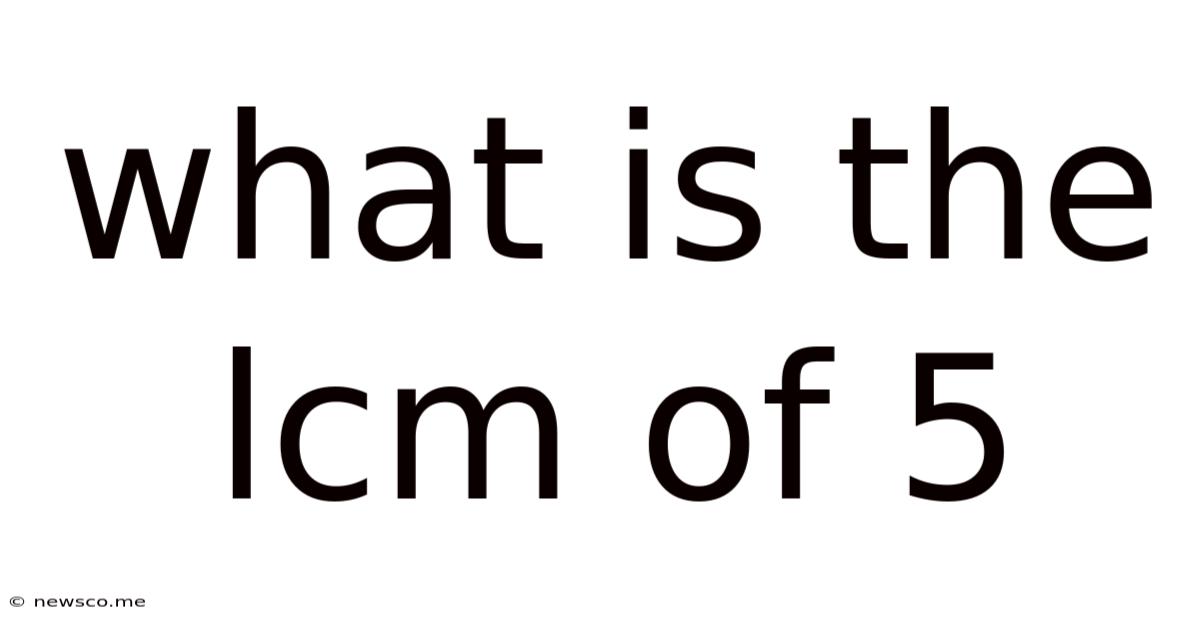What Is The Lcm Of 5
News Co
Mar 28, 2025 · 5 min read

Table of Contents
What is the LCM of 5? Understanding Least Common Multiples and Their Applications
The question "What is the LCM of 5?" might seem deceptively simple, but it opens the door to a deeper understanding of least common multiples (LCM) and their significance in various mathematical applications. This article will explore not only the answer to this specific question but also the broader concept of LCMs, their calculation methods, and their practical uses across different fields.
What is a Least Common Multiple (LCM)?
Before we dive into the LCM of 5, let's define what an LCM actually is. The least common multiple of two or more integers is the smallest positive integer that is divisible by all the integers without leaving a remainder. In simpler terms, it's the smallest number that all the given numbers can divide into evenly.
For example, let's consider the numbers 2 and 3. The multiples of 2 are 2, 4, 6, 8, 10, 12... and the multiples of 3 are 3, 6, 9, 12, 15... The common multiples of 2 and 3 are 6, 12, 18, and so on. The smallest of these common multiples is 6, therefore, the LCM of 2 and 3 is 6.
Calculating the LCM of 5 (and other numbers)
Now, let's address the main question: What is the LCM of 5? Since 5 is a prime number (meaning it's only divisible by 1 and itself), its only positive divisors are 1 and 5. Therefore, the least common multiple of 5 (when considered alone) is simply 5.
However, the concept of LCM becomes more interesting when we consider multiple numbers. Let's explore different methods for calculating the LCM of a set of numbers:
1. Listing Multiples Method:
This method is suitable for smaller numbers. We list the multiples of each number until we find the smallest common multiple.
For instance, let's find the LCM of 4 and 6:
- Multiples of 4: 4, 8, 12, 16, 20...
- Multiples of 6: 6, 12, 18, 24...
The smallest common multiple is 12, so the LCM(4, 6) = 12.
2. Prime Factorization Method:
This method is more efficient for larger numbers. We find the prime factorization of each number and then take the highest power of each prime factor present in the factorizations.
Let's find the LCM of 12 and 18:
- Prime factorization of 12: 2² x 3
- Prime factorization of 18: 2 x 3²
The highest power of 2 is 2², and the highest power of 3 is 3². Therefore, LCM(12, 18) = 2² x 3² = 4 x 9 = 36.
3. Greatest Common Divisor (GCD) Method:
The LCM and GCD (greatest common divisor) of two numbers are related by the following formula:
LCM(a, b) = (|a x b|) / GCD(a, b)
First, we find the GCD using the Euclidean algorithm or prime factorization. Then, we use the formula to calculate the LCM.
Let's find the LCM of 15 and 20:
- GCD(15, 20) = 5 (using the Euclidean algorithm or prime factorization)
- LCM(15, 20) = (15 x 20) / 5 = 60
Real-World Applications of LCM
Least common multiples aren't just abstract mathematical concepts; they have practical applications in various fields:
1. Scheduling and Timing:
Imagine you have two machines that perform different tasks. Machine A completes its cycle every 4 hours, and Machine B every 6 hours. To determine when both machines will complete their cycles simultaneously, you need to find the LCM(4, 6) = 12. Both machines will finish together after 12 hours. This is crucial in production planning and scheduling.
2. Fraction Operations:
Finding the LCM is essential when adding or subtracting fractions with different denominators. You need to find the LCM of the denominators to find a common denominator for the fractions.
3. Music Theory:
In music, LCMs are used to determine the least common denominator of rhythmic patterns. This ensures the harmonious interaction of different rhythmic parts in a musical piece.
4. Construction and Engineering:
The LCM is helpful in problems involving the periodic maintenance or replacement of parts in mechanical systems. Imagine you have to replace certain parts of a machine every 3 months and other parts every 5 months. The LCM will tell you when all parts need replacement at the same time.
5. Computer Science:
LCM finds application in tasks requiring synchronized operations, data alignment, and memory management in computer systems.
Advanced Concepts Related to LCM
The concept of LCM extends beyond simple integers. We can also find LCMs of polynomials and other mathematical expressions. This has applications in algebra and calculus. Furthermore, there are advanced algorithms for efficient LCM calculation of very large numbers, crucial in cryptography and other computationally intensive fields.
Conclusion
The answer to "What is the LCM of 5?" is simply 5. However, this seemingly straightforward question leads us to a much broader and deeper understanding of least common multiples and their practical relevance across various disciplines. From scheduling and fraction operations to music theory and engineering, LCMs play a crucial role in solving real-world problems. Mastering the calculation methods and understanding the applications of LCM is an essential skill in mathematics and its many practical applications. The more you explore LCM, the more you realize its significant role in making our world run smoothly, whether it is in a factory or in a symphony orchestra. The seemingly simple question about the LCM of 5 opens a fascinating world of mathematical problem-solving and practicality.
Latest Posts
Related Post
Thank you for visiting our website which covers about What Is The Lcm Of 5 . We hope the information provided has been useful to you. Feel free to contact us if you have any questions or need further assistance. See you next time and don't miss to bookmark.